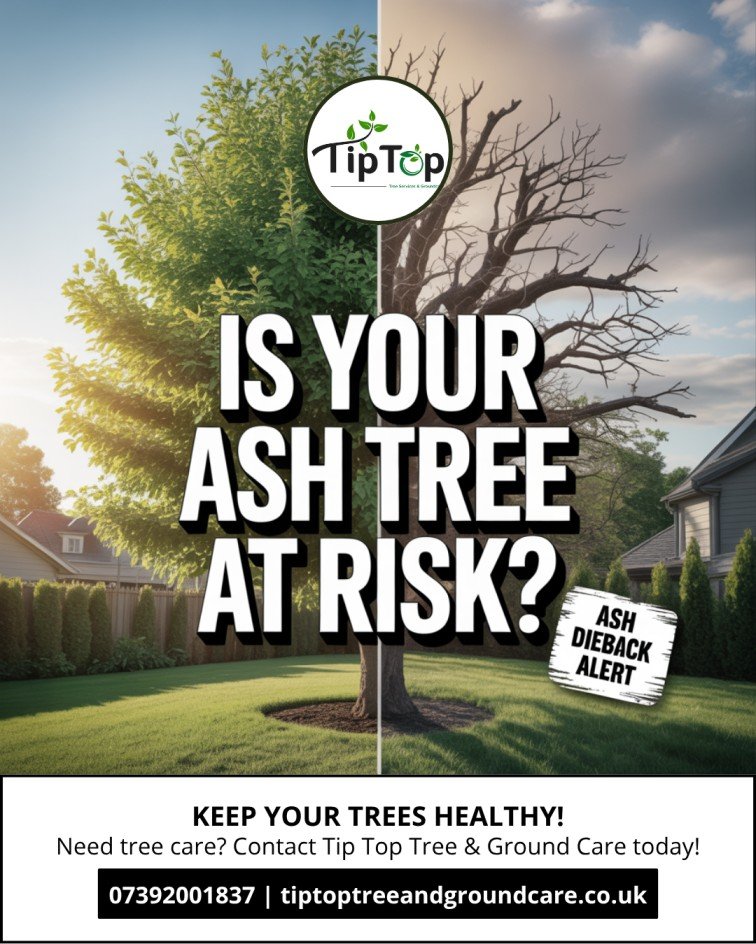Ash dieback (Hymenoscyphus fraxineus) is rapidly spreading across the UK, posing a serious threat to our beautiful ash trees, woodlands, and wildlife. As this disease continues to make headlines and impact local communities, Tip Top Tree Services is here to guide homeowners through understanding, managing, and combating this urgent tree health crisis.
What Is Ash Dieback?
Ash dieback is a fungal disease that attacks the leaves, branches, and eventually the whole structure of ash trees. First detected in Britain in 2012, it’s now widespread in Oxfordshire, Berkshire, and beyond.
Symptoms to watch for:
- Dark, blotchy patches and wilting on leaves (often visible by summer)
- Blackened leaves that may remain attached
- Diamond-shaped lesions on branches or trunk
- Crown dieback and excessive new shoots
Why Is Ash Dieback a Big Deal?
- Loss of Trees: Up to 85% of infected ashes can eventually die. Younger trees decline fastest, but even mature trees become unsafe over time.
- Wildlife & Biodiversity: Ash trees support almost 1,000 different species; losing them dramatically affects local flora and fauna.
- Safety Risks: Diseased trees can become unstable, particularly near pathways, driveways, or buildings—raising the risk of falling branches or whole trees.
What Homeowners Should Do
- Inspect Regularly: Examine ash trees from June to October for signs of infection.
- Don’t Remove Prematurely: Unless the tree is a safety hazard, consider leaving it: some might show natural resistance.
- Call the Professionals: If you’re worried about a tree’s stability, or it’s near a busy area, contact Tip Top Tree Services for expert assessment. We’ll ensure safe, eco-conscious management.
- Handle With Care: Dispose of infected branches and leaves responsibly—burn, bury, or compost onsite (never move debris offsite).
- Replant Diversity: If you must remove an ash, ask us about resilient, native substitutes that will keep your garden and local wildlife thriving.
- Know the Laws: Felling might require permission—Tip Top can manage the paperwork and check for tree protection orders.
Frequently Asked Questions
Q: What should I do if I suspect Ash dieback on my property?
A: Contact Tip Top Tree Services for a free professional assessment. Our arborists will identify symptoms, assess risk, and advise on the best course of action.
Q: Are all ash trees doomed if infected?
A: Not all. Some trees appear naturally resistant; we’ll help you decide if monitoring or removal is right.
Q: Can I remove or treat an infected ash tree myself?
A: Safely removing large or hazardous trees requires specialist experience and equipment. Tip Top is fully insured, certified, and follows all safety protocols—let us handle it.
Q: Will I need council permission to remove a tree?
A: Trees in conservation areas or under protection often need permission for removal. We’ll check and handle the necessary paperwork for you.
Q: What should I replant?
A: Tip Top recommends diverse, native species suited to your property’s conditions. We can advise, source, and plant replacements that benefit your landscape and local ecology.
Why Choose Tip Top Tree Services?

- Over 10 years’ experience serving Oxfordshire & Berkshire
- Fully certified, insured, and up-to-date with the latest biosecurity standards
- Eco-friendly, safety-focused solutions and bespoke replanting advice
- Fast, friendly service with emergency callouts and no-obligation quotes
Worried About Ash Dieback?
Don’t leave your trees or property at risk!
Tip Top Tree Services offers free assessments, expert advice, and safe, environmentally-friendly solutions for every situation.
Call us today for a free quote and protect your landscape—now and for the future!
Tip Top Tree Services: Local experts you can trust for tree health, safety, and sustainability in Oxfordshire and Berkshire.
References
Contact us to learn more or for links to official guidance!

